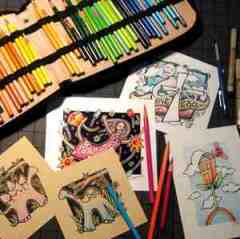A Book and Its Cover
They say you can’t judge a book by its cover. Or can you? Wandering through my favorite bookstore (you know, the old intimate kind that has floor-to-ceiling wooden bookshelves and comfy chairs in hidden corners), I can’t tell you how many times I’ve done just that. A cover will grab my eye. I’ll read the summary. I’ll decide to buy. In that order. Every time.
Good cover design is like billboard advertising for the fantastic story inside. You have only a few seconds to grab a reader’s attention, that reader whose mind is open and desperately searching for something new to read. And they’re searching among the millions of other stories next to yours as well. So make sure your cover stands out.
A tidy and well-thought cover can boost credibility and help get you noticed from the hundreds of thousands of self-published novels on the electronic shelves at the moment. They won’t be picking up your book and skimming through it to help guide their purchasing decisions. Everything that will entice them to buy is provided in the cover design, the synopsis, the sample chapters and the customer reviews.
Plus, good cover design isn’t just important to sell your book to potential readers, but when sending copies to newspapers, magazines and bloggers, that cover might get your novel noticed and reviewed. In general, the entire book industry relies heavily on cover art and design. Sales representatives will approach bookstore owners with book covers, using them as sales tools.
I stumbled upon the following helpful exercise from Suzanne Parrot, a fellow graphic designer and formatter for over twenty-five years. This exercise is a way for authors to understand the principles behind cover design, and this seems like a great habit to get into even if you weren’t in the process of designing a book cover. If I were an author I’d put it into practice immediately.
No one knows your book better than you.
Exercise: Think about the key elements in the novel.
For Example:
- Orphan Boy Wizard (hero)
- Flies a Broom; Plays Quidditch as a Seeker; catches the snitch (special talent)
- Uses a wand (weapon)
- Must save his school (location), the world, from evil (villain) by finding a magical stone (prize)
Got the picture? J.K. Rowlings’ cover art for the book, the Sorcerer’s Stone* (Philosopher’s Stone), uses key ingredients to entice, but NOT reveal the story.
Breaking down these elements into their basic parts, we can create a list to follow when you are creating your book covers. (This list is by no means definitive; feel free to add or substitute.)
Assignment Questions:
Take a few moments and jot down some elements of your story. Include the following as a guide:
- Who is your Hero?
- What are your hero’s characteristics?
- Who is your Villain? (Sometimes this isn’t a person. Is your hero battling nature, society, work?)
- What are your villain’s characteristics?
- What is the primary location of the story?
- What is the genre of the story?
- What weapons do the hero and villain use?
Check out Suzanne’s site called Unruly Guides-DIY Self-Publishing Guides, Kits & Tutorials for other helpful bits.
While it is important for your cover artist (and believe me, unless you’re an illustrator yourself, you do need to hire a professional cover artist) to read your manuscript, giving him/her the answer to these questions will help you work together to get the best cover for your manuscript.
To sum it up, wrap it up and get down to the nitty gtitty of your story. You’ve spent way too much time writing your masterpiece to enclose it with an eyesore. Give that cover some serious thought and attention and welcome those judges.
*As I’m American, I’m basing this exercise on the US cover of the first book in the Harry Potter series. The UK version is quite different. While it does have a similar cartoon figure of Harry Potter, instead of him playing Quidditch, he is about to board the Hogwarts Express. This example adds even more to the importance of cover design, in that what works in one culture may not be the best cover in another.
Kirby Kana is an artist, designer and illustrator, and through Kirby Ink she will be donating a bespoke cover design to the winner of the Self-Publish or Perish competition.

